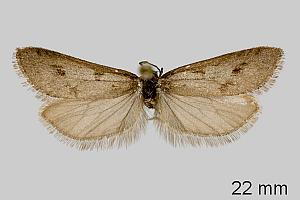3. Biologie
3.1. Nahrung der Raupe
- [Salicaceae:] Salix phylicifolia (Teeblättrige Weide)
Bruun & Krogerus (1996: 85) teilten in ihrer Erstbeschreibung aus Finnland mit: "All type specimens were collected in 1984-1986 in the first week of July as full-grown larvae. The habitats were moist meadows and bogs with willow thickets, located in coniferous primeval forests in the Kuusamo district near the border of Russia. Finds were made at two sites, about 2 km from each other. The larva feeds on Salix phylicifolia, spinning together a bunch of leaves. In colour the larva is similar to the larva of E. congelatella but has black markings on the posterior prothoracic shield margin forming contours of two eyespots (Fig. 22). Normally hidden under the skin, the eyespots become visible when the larva is disturbed. The variability of the eye-marking was not studied. The larva pupates in the leaf bunch in a silken tube."
4. Weitere Informationen
4.1. Faunistik
Locus typicus: Finnland, Kuusamo.
4.2. Typenmaterial
Bruun & Krogerus (1996: 77): “Holotype ♂, Finland: Ks: Kuusamo, Oulanka 736:61, e.p. 7.8.1986 H. Bruun, gen.slide 614 (in the Zool. Mus., University of Oulu, Finland)” — Paratypen: 6 ♂♂ und 8 ♀♀.
4.3. Taxonomie
Die erst 1996 beschriebene Art ist nicht unumstritten. Aarvik et al. (2017) behandeln das Taxon als Synonym: "We consider Exapate bicuspidella Bruun & Krogerus, 1996 as a synonym of E. congelatella (Clerck, 1789)."
(Autor: Erwin Rennwald)
4.4. Literatur
- Aarvik, L., Bengtsson, B.Å., Elven, H., Ivinskis, P., Jürivete, U., Karsholt, O., Mutanen, M. & N. Savenkov (2017): Nordic-Baltic Checklist of Lepidoptera. — Norwegian Journal of Entomology - Supplement No. 3: 1-236. [PDF auf entomologi.no]
- Erstbeschreibung: Bruun, H. H. & H. Krogerus (1996): Exapate bicuspidella sp. n., a new species of Tortricidae from northeastern Finland (Lepidoptera). — Entomologica Fennica 7 (2): 77-86. [PDF auf journal.fi]







